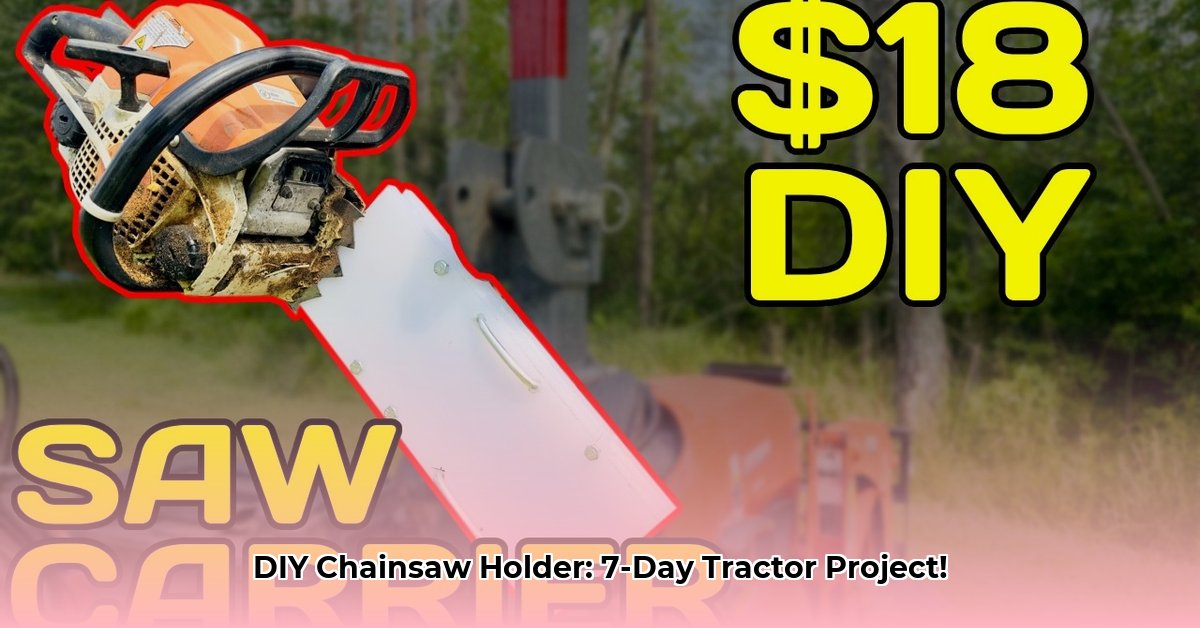
Tired of wrestling your chainsaw on and off your tractor? Building your own holder is a surprisingly straightforward project that boosts both safety and efficiency. This seven-day guide provides step-by-step instructions, along with a comparison of DIY versus store-bought options, helping you decide what's best for you. For more information on chainsaw bar oil, check out this helpful resource.
Day 1: Planning Your Project
Before you start hammering, plan carefully. What's your tractor's size and model? Knowing this will dictate your holder's design and mounting location. Precisely measure your chainsaw's bar length – this ensures a snug, secure fit. Now, gather your materials. We'll detail these later, but consider sturdy steel, heavy-duty plastic pipe (PVC is a common choice), strong bolts, nuts, and washers. Crucially, gather your safety gear: eye protection, work gloves, and appropriate ventilation if welding.
Day 2: Fabricating the Mounting Bracket
The mounting bracket is paramount. It's what attaches your chainsaw holder securely to your tractor. Steel is ideal for its strength and weldability. If welding isn’t feasible, use heavy-duty steel plates and extra-strong bolts. Carefully cut and shape the metal to fit your tractor's frame. A precise fit ensures stability and safety. Remember, a wobbly mount is a dangerous mount.
Days 3 & 4: Constructing the Chainsaw Scabbard
Next, build the scabbard, the protective shell that holds your saw. Heavy-duty PVC pipe is a budget-friendly option; just make sure the diameter snugly fits your chainsaw. Reinforce it with metal straps for added security, especially with larger chainsaws. Alternatively, for maximum durability, consider constructing the scabbard from sheet metal. This requires more skill and specialized tools.
Day 5: Assembly – Bringing it All Together
It's time to unite your components. If using steel, weld the scabbard to the bracket for a permanent, robust connection. If using bolts, ensure you use lock washers to prevent loosening. Take your time, double-checking each connection for strength and security. A poorly attached scabbard could result in a lost chainsaw – or worse.
Day 6: Mounting and Rigorous Testing
Carefully mount the finished holder onto your tractor. Select an accessible yet secure location that doesn't interfere with tractor operation. Once mounted, thoroughly test its stability. Shake it vigorously. Does it feel solid? Any wobbling or rattling requires adjustment – retighten bolts, re-weld connections, or reposition it on the tractor.
Day 7: Final Inspection and Safety Check
Before using your new chainsaw holder, conduct a final, thorough inspection. Check welds for strength, tighten all bolts, and give it another stability test. Finally, test it with your chainsaw. Does it fit securely? This meticulous inspection is crucial for safety.
DIY vs. Store-Bought: A Comparative Analysis
Building your own chainsaw holder offers significant cost savings. But is it worth the time and effort?
| Feature | DIY Chainsaw Holder | Commercial Chainsaw Holder |
|---|---|---|
| Cost | Significantly cheaper | More expensive |
| Customization | Completely customizable to your needs | Limited customization options |
| Time Investment | Requires several days of labor | Immediate availability |
| Durability | Durability depends on materials and construction. | Usually more robust and durable |
| Repair/Maintenance | Easier and less expensive repairs | Potentially more expensive repairs |
The optimal choice depends on your skills, budget, and time constraints. Building your own rewards you with a perfectly tailored solution, while purchasing a pre-made holder offers convenience and often superior durability.
Remember: Prioritize safety! A secure chainsaw holder is essential for preventing accidents. Always wear appropriate safety gear and inspect your holder regularly.